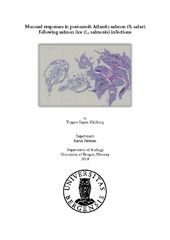Mucosal responses in post-smolt Atlantic salmon (S. salar) following salmon lice (L. salmonis) infections
Abstract
The aquaculture sector is becoming increasingly important both for food production and economic reasons. The main problem today in Norwegian aquaculture is the copepod ectoparasite Leopeophtheirus salmonis which limits the growth of the sector in Norway. It is important to limit the amount of sea lice in the industry because it affects wild stocks of Atlantic salmon (Salmo salar) and Brown trout (Salmo trutta trutta) negatively, especially in early post-smolt stages. Breeding for salmon lice resistance in aquaculture is one of the proposed solutions, and the breeding companies are currently breeding for traits connected to resistance to salmon lice. There are likely many genes affecting resistance to salmon lice, and Atlantic salmon is relatively susceptible to it compared to other salmonids. In order to make breeding for this trait feasible, better marker for innate immune responses are needed and this thesis will look at the possibility of using mucosal mapping in mapping the mucosal dynamics of sea lice infections, and compare families in a large-scale challenge test. The trial was carried out by the breeding company Salmobreed at the Norwegian institute of marine research (IMR) station at Matre, Norway. Weight turned out to have a large effect on mucosal dynamics, at least in the tail of the fish. The tail was also the favoured site for sea lice in this study. Increasing weight seemed to correlate with a weakening of the mucosal quality of the tail, and this could be a result of breeding for increased growth, and not immune function. Family data was not of good enough quality to do any statistics, but some observations were made. They tended to develop in the same way that the general population did in terms of mean weight etc.
